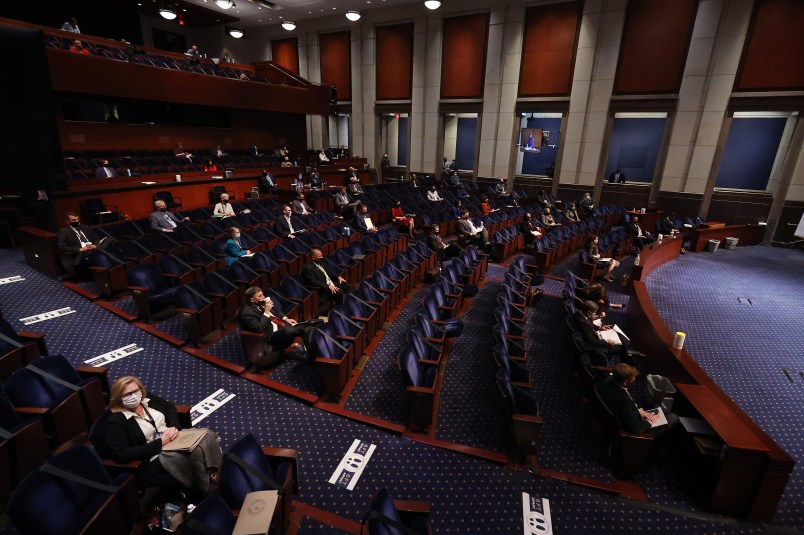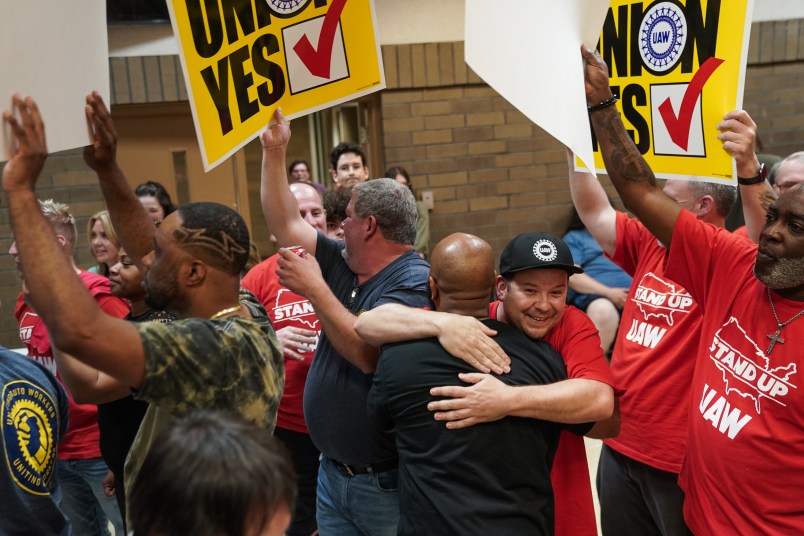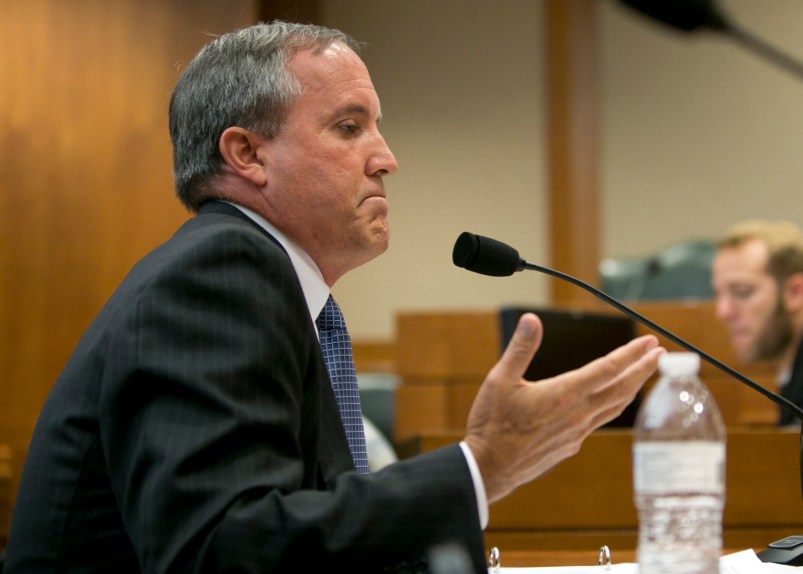This article is part of TPM Cafe, TPM’s home for opinion and news analysis. We are running a series of articles on progressive victories that came out of the 2020 election at the state and local level.
From county sheriff to Congress, in blue, red, and purple parts of the country, American voters elected one of the most diverse groups of elected officials in the nation’s history, including a Black-Indian woman as vice president.
Most of the newly-elected women, people of color and LGBT candidates are Democrats. But the Republican Party made some gains by running what the NRCC claimed was its most diverse slate of candidates ever. Adding more conservative pro-life women to Congress or state legislatures this year is not what feminists and other progressives had in mind. Less white and male, in other words, doesn’t necessarily mean more progressive.
In the House, Republicans have flipped 11 Democrat-held seats and the Democrats flipped three Republican-held seats for a net gain of eight for the GOP. Three races (CA-21, CA-25, and Iowa- 2) are still too close to call. In the Senate, the Republicans flipped one seat (Alabama), the Democrats flipped two seats (Colorado and Arizona), and two seats in Georgia, now held by Republicans, await a run-off in January.
A Record Number of Women in Congress
This year, America set a record with 47 House and four Senate races in which both candidates were women, according to the Center for American Women and Politics at Rutgers University.
The 117th Congress, which will take office in January, will have more women than at any time in American history.
The 26 women who currently serve in the 100-member Senate — 17 Democrats and 9 Republicans — is an all-time high. That number could decline if Senator Kelly Loeffler, a right-wing Republican who was appointed to that seat, does not win her run-off against Rev. Raphael Warnock in Georgia. The Senate could lose another woman if California Gov. Gavin Newsom fills Harris’ seat with a man. For certain, one newly elected woman — Republican Cynthia Lummis of Wyoming — will serve in the new Senate.
At least 117 women will serve in the House next year, besting the previous record (102) in 2019, according to the Rutgers Center for American Women and Politics. That represents 26.4 percent of all House members — a far cry from half, but also a long distance from the 13 women (3 percent) who served in the House in 1971, when feminist Bella Abzug first took office. Eighty-nine of those 117 women are Democrats and 28 are Republicans. There are three House races that are still too close to call — one (CA-21) with two men, one (Iowa-2) with two women, and one (CA-25) with a Democratic woman (Christy Smith) challenging an incumbent Republican man (Mike Garcia).
The current House Progressive Caucus has 96 members, all Democrats and 46 of them women. In January, the caucus will grow to at least 100 members, including several new women. The caucus is co-chaired by the politically savvy Rep. Pramila Jayapal of Seattle, a strong advocate of the Green New Deal, Medicare for All, immigrant rights, and workers’ rights, who has been an effective bridge builder between the caucus and Speaker Pelosi, the first woman to serve in that post.
While the 2018 election set a new record for women elected in an election cycle (36), the 2020 freshman class will include at least 26 women, including at least 9 Democrats and 17 Republicans.
This year’s new crop of progressive women — including Cori Bush (Missouri) and Teresa Leger Fernandez (New Mexico) — won seats in safe Democrat districts. In 2018, four left-leaning freshman Democratic women now called “the squad” won their seats in safe blue districts by upending more moderate Democrats in the primaries. They all easily won re-election this cycle and Rep. Deb Haaland (D-NM), a Native American woman, won reelection in her safely Democratic district.
In a clear victory for progressives, Marie Newman will represent Illinois’s 3rd congressional district in Chicago’s suburbs. In the primary, with endorsements from Bernie Sanders and Rep. Alexandria Ocasio-Cortez (D-NY), she defeated incumbent Democrat Dan Lipinski, one of the most conservative Democrats in the House, who had represented the district since 2005. In the general election, Newman defeated Republican candidate Mike Fricilone. Marilyn Strickland won her race in the state of Washington, making her the first black woman and first Korean American to represent that state in Congress.
Several Democratic women flipped Republican-held districts, too. Carolyn Bourdeaux, a college professor, won a seat in the Atlanta suburbs. Deborah Ross and Kathy Manning won their races in Republican-held districts in North Carolina, helped by a court ruling that undid the GOP’s gerrymandering there.
Most Democratic freshman women who won their races in swing districts in 2018 as part of the “blue wave” won re-election this year, despite the Republicans’ efforts to target them as too liberal for their constituents. Katie Porter, an outspoken progressive who won in 2018 in a swing district in Orange County (CA), won again this year. The others: Lucy McBath (GA), Abigail Spanberger (VA), Lauren Underwood (IL), Jahana Hayes (CT), Elissa Slotkin and Haley Stevens (MI), and Kim Schrier (WA).
In most of the races where Republicans flipped Democrat-held seats, the GOP ran female candidates. In Republican-friendly Orange County (CA), two Asian American Republican women — Michelle Steel and Young Kim — defeated freshmen Democrats Harley Rouda and Gil Cisneros, respectively.
Two years ago, Democrat Abby Finkenauer ousted Republican Rod Blum with 50.9 percent of the vote in Iowa’s first congressional district. This year, Ashley Hinson, a state representative and former TV news anchor for a local station, took the seat back for Republicans. In South Carolina, Republican state representative Nancy Mace ousted first-time Rep. Joe Cunningham, a moderate Democrat. In New Mexico, freshman Democrat Xochitl Torres Small lost her bid for re-election to Republican Yvette Herrell, a member of the Cherokee Nation.
Nicole Malliotakis returned New York’s 11th congressional district based in Staten Island to the GOP, defeating centrist freshman Democrat Max Rose. In 2018, Democrat Kendra Horn pulled off one of the year’s biggest upsets by winning an Oklahoma City area seat that had been in Republican hands for 44 years. This year, another woman, state Sen. Stephanie Bice, took it back for Republicans. Another Republican woman, Michelle Fischbach, defeated Minnesota Rep. Collin Peterson, a 10-term incumbent and perhaps the most conservative Democrat in the House. Since 1991, he represented the district that Trump won by the largest margin of any held by a Democrat.
Donna Shalala, the former president of the University of Miami and a Clinton-era health secretary, flipped a South Florida seat in 2018 but lost this year to Republican Maria Elvira Salazar in their rematch. Salazar, a charismatic former Telemundo anchor, is a fixture in the area’s conservative Cuban community. In an adjacent Florida House district, freshman Democratic Rep. Debbie Mucarsel-Powell lost to Miami-Dade Mayor Carlos Giménez.
Several promising Democratic candidates — including Gina Ortiz Jones and Wendy Davis in Texas, and Michelle De La Isla in Kansas — lost their races in swing districts. In another swing district in Los Angeles’ distant suburbs, Republican incumbent Mike Garcia is currently ahead of Christy Smith by a few hundred votes.
New Mexico became the second state to send an all-women delegation to Congress and the first state to elect only women of color to the House. The state’s three House seats will include two Democrats and one Republican.
Women made significant strides winning office at the municipal, county, and state level, including accomplishing several historic firsts.
The number of women holding statewide office — governor, attorney general, secretary of state, superintendent of education, treasurer and other posts — set another record. Currently, women hold 28.9 percent of these offices. After the new wave takes office in January, at least 30.3% of statewide posts — women will hold a total of 94, including 51 Democrats, 41 Republicans, and two with no party affiliation. Nine states are currently led by women governors — six Democrats and three Republicans — although no women were elected to gubernatorial offices this year.
Since 1971, the number of women serving in state legislatures has more than quintupled. It is likely to increase slightly again after this year’s election. There are 7,383 state legislators in the country. Currently, 29.3 percent of those seats — 2,162 — are held by women.
Only two years after winning a seat in Maine’s state House of Representatives from a rural and conservative district, Chloe Maxmin, a progressive activist who campaigned as a supporter of the Green New Deal and health care as a human right, defeated state Senate GOP leader Dana Dow in a rural area where voters supported Senator Susan Collins over challenger Sara Gideon.
Some other highlights:
Holly Mitchell, a progressive Black state Senator, won a seat on the powerful Los Angeles County Board of Supervisors, which governs the nation’s largest county. For the first time in its 150 year history, the board will be composed entirely of women — four Democrats and one Republican.
As outlined in a previous story in this 2020 progressive victories series, Charmaine McGuffey became the first female and first openly gay sheriff in Ohio’s Hamilton County after being fired for — as it’s been widely interpretted — being an out lesbian.
Rising anger has led voters to elect progressive local District Attorneys who pledged to prosecute police misconduct, limit or eliminate the use of bail to keep people in jail while they await sentencing and reduce the overall prison population. Progressive DAs who won reelection this year include Kim Foxx of Chicago, Kim Gardner of St. Louis and Rachel Rollins in Suffolk County (Boston). This year, other progressive women won their campaigns for local DA, all outlined here.
Gabriella Cázares-Kelly, a Native American woman, won her campaign to be the Pima County Recorder, which oversees elections in the Tucson area. She ran in response to the widespread disenfranchisement of Native Americans. The Democrat won 59 percent of the vote against her Republican opponent. Voters in Bakersfield, California re-elected Republican Karen Goh, the city’s first Asian American mayor. Christy Holstege won reelection to Palm Springs City Council and will become Palm Springs’ first female mayor (and was America’s first out bisexual mayor). Phoenix voters re-elected Mayor Kate Gallego. School board member Patricia Lock Dawson was elected mayor of Riverside, CA, a city of 330,000.
Urban planner Nithya Ramen, a member of Democratic Socialists of America, unseated a business-backed incumbent for a seat on the Los Angeles City Council. And Carroll Fife, a veteran Black community organizer, who helped launch the Moms 4 Housing group that has occupied vacant buildings in the city, won her race for the Oakland City Council against an eight-year incumbent.
Black Representation Reaches An All Time High
The current Congress has an all-time high number of Black senators: Cory Booker (D-NJ), Tim Scott (R-SC) and Kamala Harris (D-CA). Harris is leaving, but if Rev. Raphael Warnock wins his January run-off election in Georgia against Sen Kelly Loeffler, the number will remain the same. A number of other Black candidates — including Democrats Jaime Harrison in South Carolina, Mike Espy in Mississippi, Marquita Bradshaw in Tennessee and Adrian Perkins in Louisiana, and Republican John James in Michigan — failed in their Senate bids this year.
Every Black Democrat in the House running for reelection in 2018 won his or her race. In addition, voters sent nine new black members, all Democrats, to Congress. As a result, the number of Black House members grew to an all-time high of 53, including the lone House Republican, Texas’ Will Hurd.
Voters in 52 of those 53 congressional seats filled by Black members reelected the incumbents or replaced members who died or retired with other Black members. Texas’ Hurd retired and was replaced by a Latino Republican.
The next House will have nine new Black members: Democrats Cori Bush of Missouri, Rickie Torres of New York, Kweisi Mfume of Maryland, and Nikema Williams of Georgia will replace other Black Democrats. Democrats Marilyn Strickland of Washington and Jamaal Bowman and Mondaire Jones of New York will replace white Democrats. Republican Byron Donalds of Florida will replace a white Republican. Utah Republican Burgess Owens will replace a white Democrat. So the net gain is five Black House members. The 58 Black House members represent 13.3 percent of the House, which is equal to Black Americans’ proportion of the U.S. population — 13.4 percent.
For most of the 20th century, there were few black members of Congress. In 1950, only two Black men (William Dawson of Chicago’s South Side and Adam Clayton Powell of Harlem) served in the House. By 1970, the number of blacks in the House had grown to ten and by 1990 it reached 25.
Then and now, most Black Congress members represented majority-black districts, although some today represent districts where blacks and Latinos form the majority. But it is clear that more white Americans are supporting Black candidates. All of the nine new black congressional members elected in 2018 prevailed in predominantly white and mostly suburban districts. Among this year’s Black elected House members, Marilyn Strickland (Washington) and Mondaire Jones (New York) come from a predominantly white district.
Down the ballot, Black candidates won their races at the municipal, county, and state levels as well.
Black people currently serve as mayors of at least 55 American cities and towns, including Chicago, Atlanta, New Orleans, Charlotte, San Francisco, Washington, D.C., Birmingham, Columbia (S.C.), Jackson (Miss.), Flagstaff, Denver, Houston, Norfolk, Richmond, Newport News, Stockton, and St. Paul. Fifty of them are Democrats, one is a Republican, and four are independents. There were few mayoral contests this year, but that number will increase.
Brandon Scott won his race to become Baltimore’s mayor. In June, Democrat Ella Jones was elected the first African American and first woman mayor of Ferguson, Missouri. Dedrick Johnson was elected the first Black mayor of Texas City, Texas, a city of about 50,000 residents. Incumbent Ken Alexander was re-elected mayor of Norfolk, Virginia, while voters in Richmond re-elected Mayor Levar Stoney.
As mentioned in a previous piece in this series, Georgians in three countries elected the first Black sheriffs.
Rick Krajewski, a community organizer with Reclaim Philadelphia, won a seat in the Pennsylvania state legislature with the backing of Bernie Sanders and support from Our Revolution, DSA, the Sunrise Movement, and several unions.
As mentioned above, progressives Holly Mitchell and Carol Fife won their races for LA County Board of Supervisors and Oakland City Council, respectively.
A Growing Number of Latinos In Office
The number of Hispanic elected officials grew from 3,063 in 1984 to 5,459 in 1994, then nosedived to 4,651 in 2004, but by 2020 it has more than rebounded to about 6,700. Nationally, Latinos, make up about 18.5 percent of the U.S. population, but hold only 1.2 percent of all local, state and federal elected offices. The latest elections will likely add to that figure.
Latinos are currently underrepresented in Congress with four Senators and 39 House members — eight percent of the total in both chambers of Congress. That number will likely rise to five Senators and 40 House members come January, with 34 of them Democrats and 11 in the GOP.
Democratic Rep. Ben Ray Lujan won the U.S. Senate race in New Mexico to replace Sen. Tom Udall, a white Democrat who didn’t seek re-election. Lujan becomes the fifth Latino Senator, joining Republicans Marco Rubio (Florida) and Ted Cruz (Texas) and Democrats Bob Menendez (New Jersey) and Catherine Cortez Masto (Nevada). This is an all-time high.
The 2018 blue wave midterms brought the election of 33 Latino Democrats and six Latino Republicans. This is nine percent of the 435 House members — another peak figure. That number of House Latino/as — 39 — will increase to 40 if Rep. Mike Garcia defeats Christy Smith In California’s volatile 25th congressional district in the distant suburbs outside Los Angeles. (Garcia is ahead by a few hundred votes). But the partisan balance will shift to 31 Democrats and 9 Republicans.
Republican Tony Gonzales defeated Filipina Gina Ortiz Jones for an open seat in Texas. Three Latino/a Republicans unseated Democrats. Nicole Malliotakis ousted Max Rose in New York. Maria Elvira Salazar beat Donna Shalala in Florida. Carlos Gimenez defeated Debbie Mucarsel Powell in another Florida district. In addition to Mucarsel Powell, two other Latino/a Democrats lost their seats in swing districts — Xochitil Torres Small in New Mexico and Gil Cisernos in California. Two Latino Democrats — Teresa Leger Fernandez in New Mexico and Ritchie Torres in New York — won seats in safe Democrat districts, replacing other Latinos.
Democratic operatives are trying to understand why Latino/a voters in many parts of the country, while still overwhelmingly Democratic, shifted slightly toward Trump and other Republicans — enough, at least, to deny several well-regarded Latino/a candidates — such as Topeka Mayor Michelle De La Isla and Ammar Campa-Najjar in San Diego — seats they were expected to win.
In Arizona, a concerted grassroots campaign led by UNITE HERE, the hotel workers union, and Latinx groups targeted Latino voters and helped Biden and other Democrats carry the state. In the three vote-heavy counties with the largest Latino population — Maricopa, Yuma and Pima — Latinos backed Biden by more than 74 percent, according to a UCLA analysis. The same on-the-ground coalition helped Biden win in Nevada. Similar though smaller efforts in Wisconsin and Pennsylvania also helped Biden win those states. The fact that Texas was even considered a swing state is a testament to the Democrats efforts among Latinos and white suburbanites, but the party lacked the organizing infrastructure that was so successful in Arizona and Nevada.
City Councilman Vicente Sarmiento, a Democrat, won his race for mayor of Santa Ana, CA, a predominantly Latino city of 332,000 residents, the nation’s 57th largest. He’s the city’s first new mayor since 1994. Phoenix voters reelected Mayor Kate Gallego.
Among the growing number of progressive local District Attorneys are several Latino/as, including George Gascon in Los Angeles County, Jose Garza in Travis County (Austin) and Mark Gonzalez in Nueces County (Corpus Christi).
The mobilization of Arizona’s Latino/a voters helped catapult Democrat Anna Tovar, Mayor of Tolleson, onto a seat on the powerful state Corporation Commission, which regulates public utilities. Her victory narrowed the Republicans’ control of the board from 4-to-1 to 3-to-2, laying the groundwork for flipping another seat in the next election.
Eighty-six Latinos currently serve in state Senates (4.2 percent of the total) and 243 represent state assembly or state house districts (4.5 percent). That number is likely to increase slightly as a result of this year’s elections. One of them is Ricky Hurtado, a son of working-class immigrants, a first-generation college student, a community organizer and director of a nonprofit group that helps other first-generation and immigrant students overcome barriers to attend college. He will be the first Latino Democrat in North Carolina’s state legislature. The 31-year old Democrat defeated a Republican incumbent by 395 votes in a rural district that has long been a GOP stronghold with a history of racial tensions. His campaign focused on improving public schools and raising teacher pay.
Maurice Ferre, a Puerto Rican who became mayor of Miami in 1973, was the first Latino mayor of a major U.S. city, followed by Henry Cisneros in San Antonio in 1981 and Federico Pena, elected mayor of Denver in 1983. Since then, voters in many of America’s major cities — including cities without large Latino populations — have elected Latino mayors: Albuquerque, Austin, Corpus Christi, El Paso, Los Angeles, Newark, Sacramento, San Jose, Santa Ana, Stockton, Tampa, and Wichita. This year, Todd Gloria — a Latino, Filipino, and Native American — became the first person of color and first openly gay person to serve as San Diego’s mayor, while Daniella Levine Cava was elected mayor of Miami-Dade County and Victor Gordo, a longtime City Council member, won his campaign for mayor of Pasadena, a Los Angeles suburb of 140,000 residents.
A Record Number of LGBT Candidates
At least 1,000 LGBTQ candidates ran for office this year — the highest in history, according to the LGBTQ Victory Fund. Those who won their contests expanded the number of LGBTQ office holders at the local, state and national levels to an all-time peak, beyond the 698 openly LGBTQ elected officials in 2019.
New Yorkers Ritchie Torres and Mondaire Jones both won their races for Congress and will be the first Black gay men in the House. They will join Reps. David Cicilline (D-RI), Angie Craig (D-MN.), Sharice Davids (D-KS), Sean Patrick Maloney (D-NY), Chris Pappas (D-NH), Mark Pocan (D-WI), and Mark Takano (D-CA), along with Senators Kyrsten Sinema (D-AZ) and Tammy Baldwin (D-WI), as members of the congressional LGBTQ caucus. The 11 LGBTQ members is an all-time high.
Many LGBT candidates won seats in state legislatures, often becoming the first openly gay legislators in their states.
Voters in Florida elected Shevrin Jones as the state’s first openly LGBTQ state senator, while Michele Rayner-Goolsby Michele Rayner, a criminal defense and civil rights attorney, will become the first openly LGBTQ Black women in Florida’s House of Representatives. David Ortiz will be Colorado’s first openly bisexual state legislator. New Mexico elected its first two LGBTQ state representatives, Roger Montoya and Brittney Barreras.
Voters in Georgia elected the first out LGBTQ state senator, Episcopal priest Kim Jackson. Torrey Harris will be the first LGBTQ member of the Tennessee state House of Representatives. Mauree Turner will be Oklahoma’s first LGBTQ (as well as its first Muslim) state legislator. In August, Adrian Tam won an upset Democratic primary victory over a 14-year incumbent in the Hawaii state House of Representatives. This month he defeated his Republican opponent, making him Hawaii’s only openly LGBTQ elected official. Jabari Brisport will be the first gay person of color elected to the New York state legislature. Lawyer and human rights activist Ann Irma Rivera Lassen, former head of the island’s Bar Association, will serve in Puerto Rico’s Senate, making her the first Black, openly lesbian Puerto Rican to become an elected lawmaker.
The number of trans state legislators almost doubled this year, from four to seven. Sarah McBride became the highest-ranking openly trans official in the country when she won her race for Delaware state Senate. Stephanie Byers, a Wichita school teacher and a member of the Native American Chickasaw Nation, will be the first trans lawmaker in the Kansas state house of representatives. Voters in Colorado reelected Brianna Taylor, a trans member of the state House of Representatives. Taylor Small, the 26-year old director of a health and wellness program that serves the state’s LGBTQ community, will be Vermont’s first openly transgender legislator.
Twenty-five year old Alex Lee won a seat from San Jose in the California Assembly, becoming the youngest state legislator in more than 80 years and the first California legislator to have come out as bisexual.
Many other LGBTQ candidates won their races for local office. Christy Holstege will become Palm Springs’ first female mayor and America’s first out bisexual mayor. As mentioned above, lesbian Charmaine McGuffey won her campaign to become the sheriff of Ohio’s Hamilton County. Bevan Dufty and Rebecca Saltzman were reelected to the board of the BART, the Bay Area’s transportation agency, where lesbian Janice Li already serves. Voters also elected Jovanka Beckles, a Black lesbian and DSA member, to the BART board.
More Diversity Overall
There are currently four native Americans in Congress — Republicans Tom Cole and Markwayne Mullin from Oklahoma and Democrats Sharice Davids of Kansas and Deb Haaland of New Mexico. They will be joined in the next Congress by Republican Yvette Herrell from New Mexico.
A record 20 members of the 116th Congress (3.8 percent of the total membership) are of Asian, South Asian, or Pacific Islander ancestry. Seventeen of them (16 Democrats, 1 Republican) serve in the House, and three (Tammy Duckworth, Mazie Hirono and Kamala Harris, all Democrats) serve in the Senate. The Asian American caucus will grow when the new House takes office in January, including three Korean American women — Republicans Young Kim and Michelle Steel from Florida and Washington Democrat Marilyn Strickland. More Asian Americans will fill state legislative seats, including restaurant owner Francesca Hong, a Madison Democrat who will be Wisconsin’s first Asian American legislator, and architect, magazine editor, and community organizer Nikil Saval, a DSA member from Philadelphia, who will be the first Asian American elected to the Pennsylvania state Senate.
Two Muslim women were elected to Congress in 2018 and reelected this year. They joined Andre Carson, a Black Indiana Democrat. Madinah Wilson-Anton (in Delaware), Iman Jodeh (Colorado), and Christopher Benjamin (Florida), who will become the first Muslims elected to their state legislatures. Samba Baldeh will be the first Muslim and first Black man in the Wisconsin legislature. In addition to becoming the first nonbinary state legislator in American history, Mauree Turner also is the first Muslim state legislator in Oklahoma.
Jenifer Rajkumar, an immigrant rights advocate, and Zohran Mamdani, a Democratic Socialists of America-backed housing activist, will become the first South Asian members in the New York state assembly. City Council member Farrah Khan, Democrat, is the first Muslim and first person of color to be elected mayor of Irvine, California, the nation’s 72nd largest city with 287,000 residents.
Peter Dreier is professor of Politics and the founding chair of the Urban & Environmental Policy Department at Occidental College. His books include Place Matters: Metropolitics for the 21st Century, The 100 Greatest Americans of the 20th Century: A Social Justice Hall of Fame, and the forthcoming Baseball Rebels: The Reformers and Radicals Who Shook Up the Game and Changed America.









